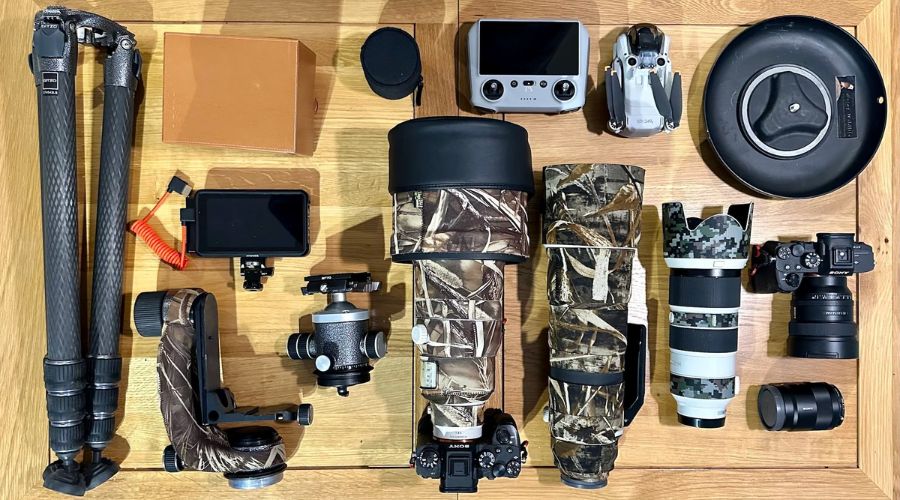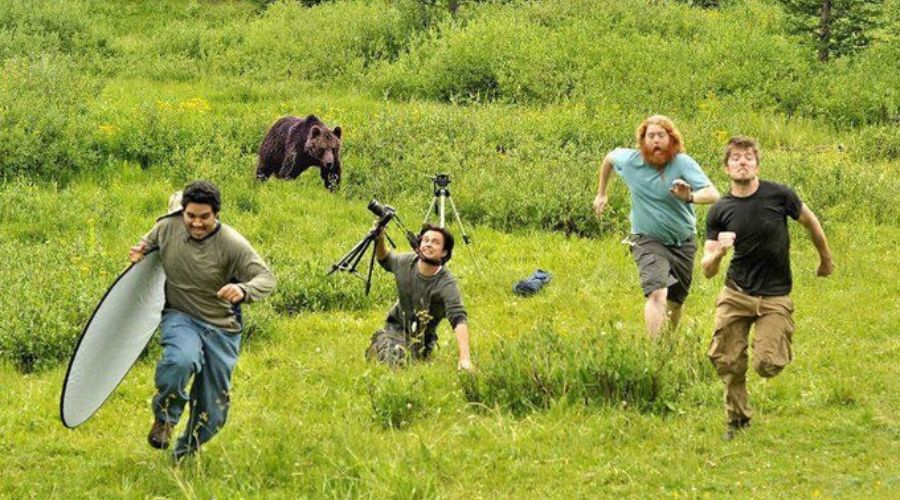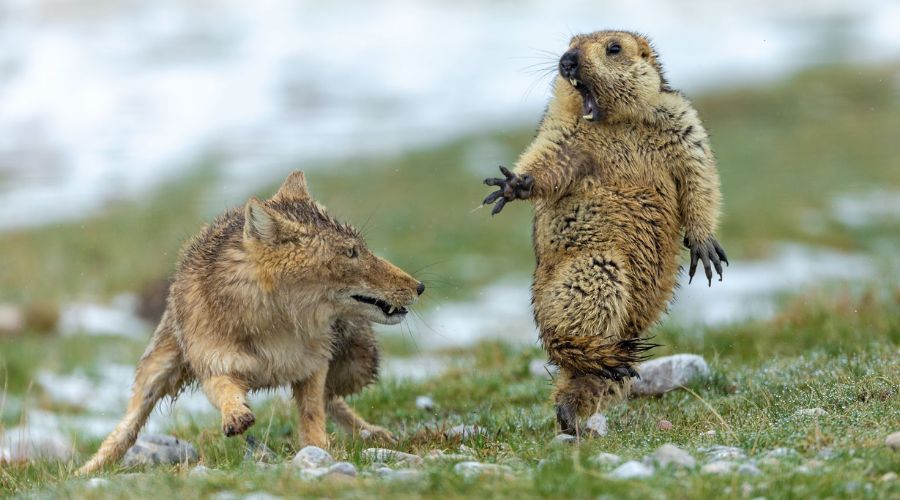Essential Equipment for Wildlife Photography
Before you venture out into the wild yonder, gear up right to snag those jaw-dropping wildlife shots.
Think of your camera as your wildlife whisperer; it’s going to help you chat up those critters from afar without so much as a howdy-do.

Choosing the Right Camera and Lenses
Ditch the notion that you need a camera fancier than a peacock at a garden party.
A sturdy DSLR or mirrorless system will do you just fine. Grab a lens that can zoom faster than a hare in a hat — something like a 70-300mm zoom lens should be your bread and butter.
Remember, in wildlife photography, reach is the name of the game, and getting up-close without spooking your subject is key.
Supporting Gear: Tripods, Blinds, and Camera Traps
It’s not all just shoot and scoot; you’ve got to play the waiting game. A rock-solid tripod is your best pal when you’re playing the patience game.
But hey, why stand when you can hide?
Pop into a camouflage blind and you’ll vanish like a ghost in the fog, all while keeping your eyes peeled for the perfect shot.
For a sprinkle of magic, set up a camera trap and let those critters come to you — it’s like fishing, but you catch photos instead!
Carrying and Protecting your Equipment in the Field
You’re not a pack mule, so don’t lug around more than you can shoulder.
A snug, waterproof backpack will shield your precious gear from the elements. Toss in some silica gel packets to keep moisture at bay — think of them as your gear’s little umbrellas.
Whether you’re crossing creeks or scrambling over rocks, your equipment stays safe, so you can focus on the fun stuff.
Now that you’re clued up on your kit, you’re ready to take wildlife photos that’ll make your friends greener than a jealous parrot.
Remember, in the great outdoors, Mother Nature’s your dance partner, so mind her toes and she’ll help you waltz into wildlife photography like a pro.
Technical Skills Required for Wildlife Photography
First things first: knowing your way around a camera is key.
You can have all the patience in the world, but if you can’t manage your settings, well, you’re about as useful as a screen door on a submarine. So, let’s dive in!

Mastering Camera Settings for Sharp, Well-Exposed Shots
Think of your camera as a wild beast you need to tame.
Shutter speed? It needs to be quick to catch a squirrel mid-sprint. Aperture? Wide open for that majestic eagle and snug as a bug for landscapes. ISO? Crank it up for the shady spots but keep it low when the sun’s smiling. And focus? Keep it sharper than a fox chasing dinner.
The Role of Light in Wildlife Photography
Now let’s chat about Mother Nature’s spotlight – light. Early bird gets the worm and the best light.
Golden hour? It’ll sprinkle magic on your photos.
But remember, like a raccoon’s dinner plans, light is a fickle friend; it can turn harsh and ruin the party. Work with it, not against it, and your photos will sing.
Understanding Animal Behavior for Better Compositions
Animals. They’re the stars of the show but don’t follow a script. To capture their essence, you’ve got to play detective. Study them, predict their next blockbuster move, and be ready.
Sometimes, it’s the quiet before the storm that tells the best tale. So, learn their habits, respect their space, and you might just get that standing ovation shot.
Peek through that lens with confidence, patience, and a dash of luck. Keep these tips in your back pocket, and you’ll be telling stories through your lens that folks can’t help but gather ’round to see.
Field Techniques and Practices
To snap those breathtaking wildlife photos, you need more than just a camera and a love for animals.
You’ve got to hone your field techniques and practices – just like a baseball player needs to practice their swing before hitting a home run!
Finding and Approaching Wildlife without Causing Disturbance
Playing a game of hide and seek with animals is part of the fun.
Remember, they’re not coming to you; you’re stepping into their living room. Use your stealth mode – move slowly, quietly, and with purpose.
Wear earth-toned clothes to blend in because you don’t want to be the person who shows up at a wildlife party wearing neon!
Understand the habits and habitats of the critters you’re after. Are they party animals at dawn or night owls? Use natural cover and the wind to your advantage – you don’t want your scent to announce your arrival like a loud neighbor.
Positioning and Timing for Optimal Shots
It’s all about being at the right place at the right time. And in wildlife photography, that’s usually when the sun paints the sky with its morning and evening glow. Think of it as nature’s own Instagram filter. Get low to the ground for those eye-level shots because perspectives matter – you want to see eye to eye, not talk down to your furry or feathered subjects.
Patient as a cat stalkin’ a mouse, that’s how you’ve got to be. Great shots don’t happen in a snap. You might be waiting longer than kids on Christmas morning, but remember, patience is a virtue, especially in wildlife photography.
In-the-field Ethics: Do No Harm
Treat the wilderness like Grandma’s living room: you wouldn’t want to mess it up. Keep a respectful distance.
If you’re causing a critter to change its behavior, back off. You’re there to capture their natural beauty, not to turn their home into a photoshoot set.
Speaking of home, leave everything as you found it. This ain’t a souvenir shop – sticks, rocks, and leaves stay put. And don’t forget, sharing is caring.
Spread the word about wildlife and conservation through your photos, but keep the location to yourself. It’s like a secret fishing spot; if too many folks show up, the fish stop biting.
By adhering to these field techniques and ethical guidelines, your wildlife photographs will not only tell a story but also foster a connection between the viewer and the natural world.
And who knows, your next photo could be the one that gets everyone talking about the beauty and importance of preserving the habitats you’ve ventured into.
Composition and Artistry in Wildlife Photography
When you’re out in the wild, all set to photograph nature’s wonders, remember that a good wildlife photo is more than a clear shot of an animal.
It’s about capturing a scene that speaks to the viewer. Your composition is key, and it’s where your creative juices really get flowing.
Rules of Composition: From the Rule of Thirds to Leading Lines
Grab your camera and think of it as a painter’s canvas.
The Rule of Thirds is your best buddy – imagine a tic-tac-toe board on your viewfinder. Placing the subject off-center at one of the intersections makes the photo a zinger!
Leading lines are the breadcrumbs that guide your viewer’s eyes through the photo – could be a trail, a stream, or even the animal’s gaze.
Using Natural Elements to Enhance Visual Appeal
You’re not just snapping pics of critters, you’re painting with light and shadow!
Use the golden rays of a sunrise or sunset to bathe your subject in warm hues. Trees, rocks, or water can frame your wildlife subject, giving your photo a pinch of drama.
It’s all about using what Mother Nature throws your way to make your shot a ten on ten!
The Art of Storytelling through Wildlife Imagery
Every creature has a tale, and your photo can spin it without words. Focus on the expressions and behavior of animals to give your audience a sneak peek into their daily lives.
A picture of a bear catching a fish or a bird feeding its chick can turn your photo album into a storybook. Keep an eye out for those special moments; they’re the golden nuggets in wildlife photography!
Keep these tips in your back pocket, and you’re sure to capture some wall-worthy shots. Now go out there and tell the story of the wild through your lens – break a leg!
Post-Processing Techniques for Wildlife Photos
Taking the shot is just the beginning of the journey in wildlife photography. The magic often happens behind the computer screen.
Post-processing can turn good photos into great ones by enhancing details that bring your wildlife images to life. You will need the right software and a bit of know-how to make your photos pop.
Essential Software and Tools for Editing
First things first, let’s talk tools. Think of your computer as a digital darkroom. Software like Adobe Lightroom and Photoshop are the bread and butter for photo editing.
But don’t get your feathers ruffled if you’re not a tech whiz—these programs come with presets and auto adjustments to get you started. They’re pretty intuitive once you get the hang of it.
And for those on a budget, fear not! Apps like GIMP offer a free alternative that’s no slouch in the editing department.
Adjusting Exposure, Contrast, and Color for Vivid Images
Now, let’s turn that drab photo into something fab. Adjusting the exposure will light up your subject just right.
Too bright? Dial it down a notch. Too dark? Crank up the exposure like turning up the dial on a sunlamp.
Contrast is your next best friend. It’s the difference between the darks and lights, giving your photo the drama it deserves.
And don’t be shy with colors–boosting the vibrancy can make your subject’s fur, feathers, or scales jump out of the frame.
Cropping and Sharpening for Impact
Got a great photo but there’s too much going on? Cropping can help. It’s like using a magnifying glass to zoom in on the action.
You can cut out the extras and focus on what’s important. And remember, a sharp photo is a good photo.
Sharpening highlights the details, from the twinkle in an animal’s eye to the texture of its hide. It’s like giving your photo a crisp high-five – it just feels right.
Remember to sprinkle in a bit of your personality. Play around with these tools, and don’t be afraid to experiment.
Challenges and Ethical Considerations
Embarking on the adventure of wildlife photography, you’re bound to run into a wild merry-go-round of challenges. It’s like trying to capture lightning in a bottle: you need patience, speed, and a sprinkle of good luck.
But sneak in some ethical considerations and you’re walking a tightrope, balancing your desire for the perfect shot against the need to respect our furry or feathered subjects.
Dealing With the Unpredictability of Wildlife
Speaking of challenges, critters don’t take direction well – they’re not your average photo models. So you’ve got to play the waiting game, sometimes for hours, just to snap that beaver damming or the eagle landing.
Remember, Mother Nature doesn’t always play nice; she’s got mood swings that can turn your photo session upside down. Weather, lighting, and creatures on their own timetable mean you’ve got to roll with the punches.
The Ethics of Wildlife Interaction and Intervention
Leap into the bush with your camera, but don’t leave your manners at the door.
Getting close-ups of a bear’s snout is thrilling, sure. But if he’s eyeing you like a plate of salmon, you might be too close for comfort.
Keep a safe distance – use that zoom lens instead of your legs. It’s not a game of tag. Plus, feeding or baiting animals for that award-winning shot? That’s a big no-no. Let’s keep the wild in wildlife, okay?
Action can be behind the lens too. Don’t just shoot photos – shoot for making a difference. Your images can tell powerful stories, pulling heartstrings, and raising awareness for conservation.
Maybe you’re the next wildlife photojournalist superstar, getting folks to think twice about environmental issues.
Snapping It All Together: Your Wildlife Photography Roundup
Well, butter my biscuit, look at you! You’ve just flipped through the complete guide to taking wildlife photos like a champ.
Just remember, Rome wasn’t built in a day, and neither is a pro photographer’s portfolio. Keep your eyes peeled and your camera ready—nature’s critters aren’t known for giving heads-up before a picture-perfect moment.
Before you scamper off into the wild, remember that patience is the name of the game. Like fishing, you’ll wait for the big one, but when it comes, oh boy, the thrill is real!
Stick to the basics, respect your furry and feathered friends, and the snapshots will follow. Your next great adventure is just a shutter click away.
Hold onto your hat, because once you start, there’s no going back. You’ll find there’s nothing quite like the rush of capturing a bird in flight or a deer mid-graze.
So, share your stories, flaunt your photos, and keep this guide in your back pocket.
Frequently Asked Questions
What equipment do I need to start taking wildlife photos?
Picture this: you’re out in the great outdoors, ready to snap that perfect shot. You’ll need a trusty camera, a lens with a good zoom, and a steady hand. A tripod wouldn’t hurt either. And don’t forget those extra batteries and memory cards. They’re like snacks for your camera, keeping it going as you capture the wild moments!
How close should I get to animals for a good photo?
Keep it safe, folks! Those critters aren’t pets, and getting too cozy could spell trouble. Use your zoom lens to grab a tight shot from a distance. This way, you’re respecting their space, and they’re less likely to bolt. It’s like being a photo ninja, getting the shot without them even knowing you’re there.
What’s the best time of day for wildlife photography?
The early bird gets the worm, or in your case, the best light. Sunrise and sunset are the golden hours that’ll give your photos that extra wow factor. Animals are more active then too, so you’re likely to get some action shots. Just remember, timing is everything!
How can I capture sharp wildlife photos?
Stability is your friend here. Use a tripod to keep things steady or bump up your shutter speed to freeze the action. Practice your panning; it’s like dancing with your camera. Keep it smooth and follow through, just like you would if you were throwing a ball.
Do I need to understand animal behavior for wildlife photography?
Oh, you betcha! Knowing what makes them tick can be the difference between a snapshot and a masterpiece. Spend some time observing them – it’s like detective work! The more you know, the better you’ll be at anticipating their next move and clicking that shutter at the perfect moment.
What should I wear when out taking wildlife photos?
Dress to blend in, not to stand out. Earth tones are your BFFs in the wilderness; they’ll make you part of the scenery. And layers, layers, layers – you want to be ready for any weather throwdown. Comfy shoes with good grip are a must, ’cause you might be on your feet for a good while.
How can I respect wildlife while photographing them?
Respect is the name of the game. Keep a respectful distance, don’t try to lure them with food, and absolutely no funny business to get their attention. If they look stressed, give ’em space. Think of yourself as a guest in their home; you wouldn’t want someone chasing you around your house with a camera, right?

